

The species was known to Carl Linnaeus already in the 18th century, and it was Linnaeus who assigned the specific epithet 'nutans' in his Syst. Nat. ed. X, 2:1214, 1759, where the total identifying description of the species (under the genus Tussilago) was:
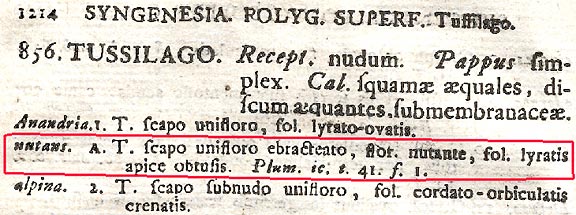
In his 1944 treatment of C. nutans A. Burkart notes ("Estudio del género de compuestas Chaptalia." Darwiniana 6:565):
Extracts from Burkart's drawings for C. nutans and C. nutans var. texana are shown below.
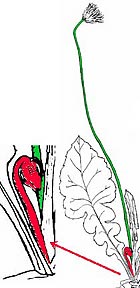 |
 |
|
| C. nutans, Burkart, Fig. 12 | C. nutans var. texana, Burkart, Fig. 13 | |
|---|---|---|
| Drawings extracted (and colorized) from Burkart 1944 | ||
While the bud [red] is clearly pendent, the slightly tilted heads shown at (presumed) anthesis are not bent downward, and do not seem likely to have qualified as ‘nodding’ for 18th Century botanists, who apparently took such terms seriously. For example, James Lee 1776 (An introduction to the science of botany, p. 493) list distinct terms appropriate for the orientation of the peduncle, including:
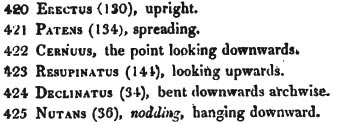
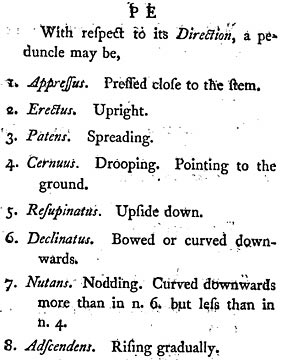
R. J. Thornton, A Grammar of Botany, 1818, provided more clarification:
The Oxford English Dictionary recognizes the special botanical usage of ‘nodding’:
The Glossary of D. S. Correll & M. C. Johnston, Manual of the Vascular Plants of Texas (1970) provides somewhat similar definitions, but doesn't maintain the earlier distinctions:
The Oxford English Dictionary also provides nonbotanical definitions for nod which might seem to be the basis for some of the confusion; e.g., for the verb:
And noteworthy is their description of nodding with C. tomentosa:
The species may be recognized by the orientation of the heads; when immature or as the achenes are shed they are nodding but at anthesis they are upright.
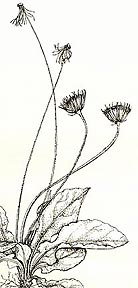 |
 |
 |
| C. nutans, Simpson, Fig. 102 | C. nutans, Nesom, Fig. 7 | C. texana, Nesom, Fig. 8 |
|---|---|---|
| Drawings extracted (and colorized) from Simpson 1975 & Nesom 1995 | ||
And Nesom 1995 (Revision of Chaptalia (Asteraceae: Mutisieae) from North America and continental Central America. Phytologia 78:153–188) presents drawings said to show the habit of the two species, extracted above. The C. nutans bud [red] does indeed meet the above conditions for ‘nutans’, but the dispersal stage [left] head of C. texana] is quite rigidly erect.
So how are we to make sense out of this?
For starters, my own experience has been limited to Chaptalia in Central Texas: with the pressed specimens in the TEX/LL herbaria, also from UTEP, SR and US, plus intensive contact with 4 different populations in Central Texas (as illustrated and documented on this website). But since I have no knowledge of C. nutans other than what is in the literature (noted above), my discussion must be limited to C. carduacea & C. texana.
My inspection of herbarium specimens tells me that evidence for this habit is not to be found in the mounted specimens. One exception was an atypical C. carduacea specimen from Val Verde County with a sharply drooping head (!cernuous), with a peduncle twist of greater than 180° (below left). An even more extreme twist has been observed with C. carduacea, which generally has a much stronger drooping posture (below right). It is probably not coincidental that both instances were in late fall/early winter.
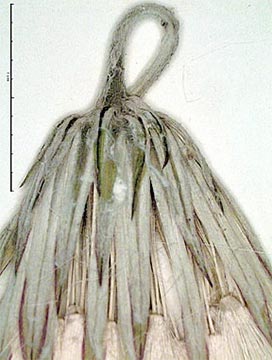 |
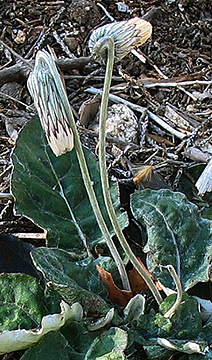 |
| 24 Nov. 1984 B. Ertter et al 5516 (TEX) |
C. carduacea, 4 Dec. 2010 (click for large image) |
|---|
In spring 2010 I documented two distinct nodding forms, but after following this phenomenon through spring 2011 I realized that the nodding behavior is very complex, and certainly not a characteristic that can be reduced to ‘nodding’ vs. ‘erect’ as in current taxonomic descriptions. A complete revision of my earlier views is presented on a separate page.